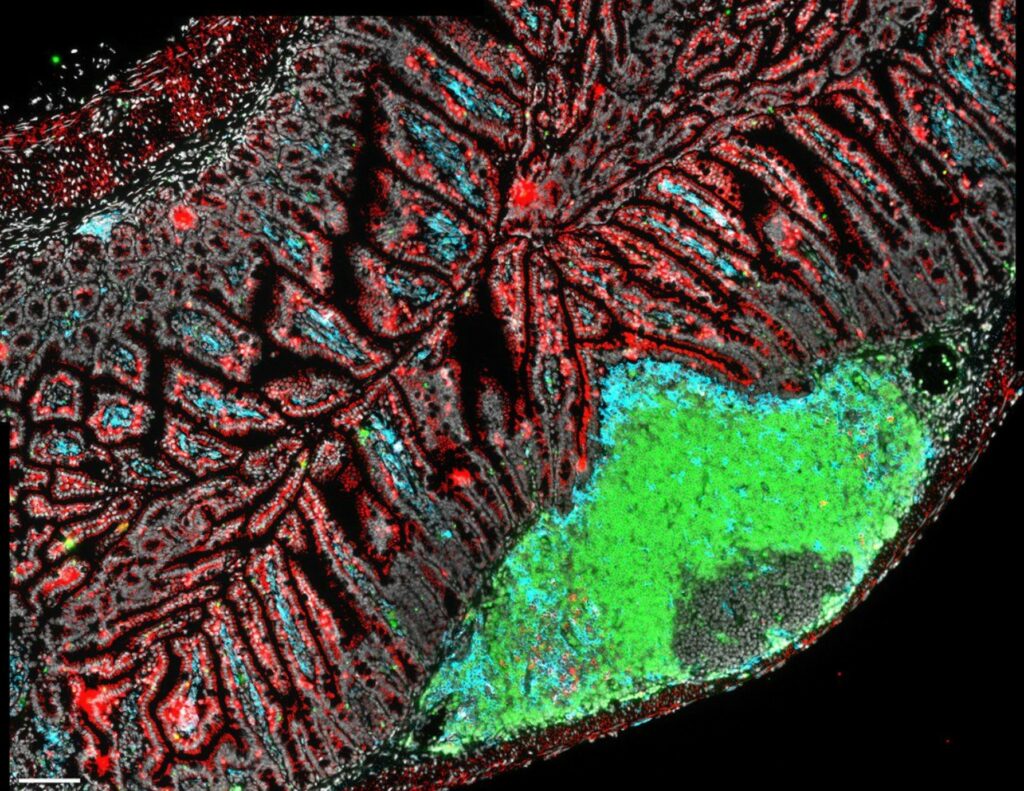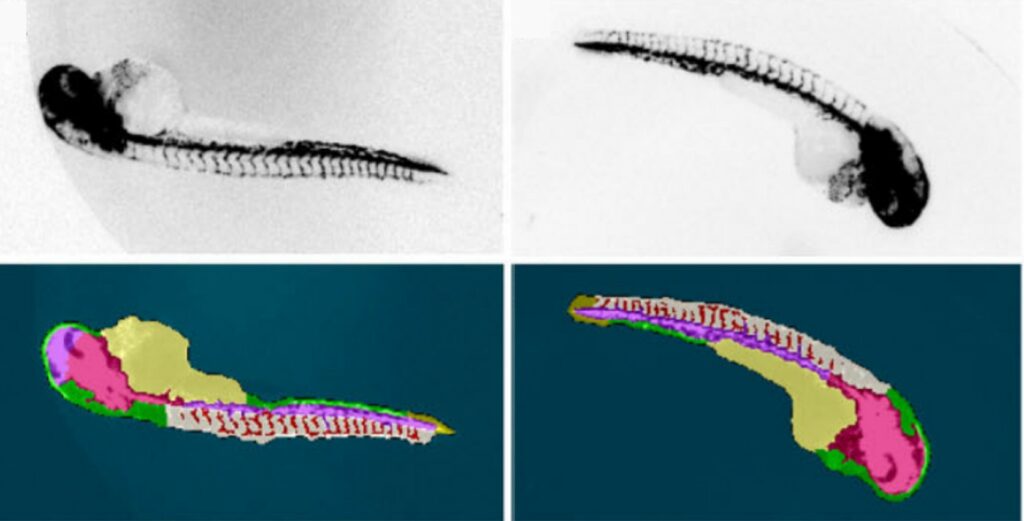In the USA, January is characterized by creativity. In fact, the creativity month celebrates outside-the-box-thinking, the expression of ourselves and the innovations. To match with this idea, we decided to highlight some original uses of zebrafish and related technologies, for which researchers have had to be creative. Some of them are: the use of zebrafish as environmental sensors, as a model to study microbiome-host interactions, as a tool for personalized medicine, on the possible uses of artificial intelligence, and finally, on a double mutant strain called “casper”.
Zebrafish as environmental sensors
Zebrafish can be considered as an environmental sensor because they are highly respondent to environmental changes, involving alteration in swimming, mating or feeding behaviour (1). Furthermore, aquatic environments are good estimators of pollution because they are the recipient of industrial and domestic pollutant compounds. Aquatic organisms are directly impacted by them and nefast impacts are also observed on species higher in the food chain (e.g. on humans) (2). A great advantage that zebrafish have as a model for environmental sensors is that toxicity response can be tested at a very early developmental stage, without the use of adults. (3)
Pollutants are represented by pesticides, environmental estrogens and heavy metals.
Pesticides are used in agriculture to prevent or treat the presence of nefast insects. In presence of organophosphorus insecticides, zebrafish present an inhibition of acetylcholine channels, which leads to physiological effects (4). The Sevin pesticide involved retardation in development of zebrafish larvae and a delay in hatching time (5).

Environmental estrogens are endocrine disruptive chemicals altering hormone signaling in the body. When humans are exposed to them, a decrease in semen quality, a decrease in sperm count, an increase in breast cancer and urogenital tract malformations are observed. In fish, environmental estrogens involve disruption in reproductive development by feminization of males and alteration of sexual behaviors. To detect exogenous and endogenous estrogen searchers have developed an estrogen-responsive transgenic zebrafish (3).
Heavy metals are dangerous for health because of their highly reactive ions. They can lead to osmolarity imbalance, neural malfunctions or cancers (6). Detection of heavy metal can be realized with transgenic fish, sensitive to heavy metal. One approach is related to the metallothioneins proteins, on which the transcription is activated by the presence of mercury, copper, cadmium or zinc. When the transcription is activated, fluorescence will be observed (2).
Zebrafish to study microbiome-hosts interations
The microbiome is defined as symbiotic bacteria, pathogenic bacteria and fungi living within a host (7,8). Symbiotic bacteria are essential to the host organism because they perform functions that the host cannot accomplish itself (7).
Zebrafish are a powerful model to study microbiome because they have a similar intestine with humans in terms of structure and mode of action, it is possible to obtain germ-free zebrafish, which allow tests of the effects of single bacteria species. Furthermore, microbial partners are cultivable in vitro and are sensitive to genetic manipulation (7,9). But an aspect that can be inconvenient is that it is really difficult to raise a germ-free zebrafish to adulthood (10).

Some studies have already highlighted impacts of microbiome on host. For example, it has been proved that it plays a role in bone calcification, immunity system and resistance to environmental pollutants (7). Microbiome has also been linked with some diseases such as type 2 diabetes, obesity and colon cancer (9).
The microbiome influences the host by the release of chemical compounds, which interact with host molecular receptors or with other molecules like environmental pollutants. In fact, microbiomes have the ability to bioactivate or deactivate environmental compounds (11).
Microbiome functions are dependent on the microbiome composition and the sex of the host. The sex is a major determinant of the microbiome composition (12,13).
Zebrafish as a tool for personalized medicine: xenografts
A xenograft is defined as cells of other species transplanted in a host organism. In the case of personalized medicine, human cells are implanted in zebrafish (14).
Their major use is to study human cancer. Patient tumorous cells can be implanted in a zebrafish embryo. To visualize the xenograft, tumor’s cells are often coupled with fluorescence (15). This allows the direct test of anti-tumoral drugs, to better understand tumor microenvironment, to track metastasis or to identify some angiogenesis pattern (15,16).

If you want to learn more about the use of xenografts in personalized medicine, we invite you to read our article “How can zebrafish embryos help to find a personalized treatment for leukemia”.
Zebrafish research related to AI
Artificial intelligence (AI) has numerous advantages involved in the scientific field and more precisely in zebrafish studies. Firstly, it allows a rapid analysis of a large amount of data. Secondly, errors associated with manual analyses are reduced and so more objective and reproducible results are obtained (17).
In zebrafish research, AI methods can be used to (17):
- Automatically identify and classify morphological features of zebrafish embryos and larvae: it is useful to analyze embryonic development, to predict disease, to analyze drug effects. Some identifiable points can be the body size or the pigmentation.
- Analyze zebrafish behavior
- Understand the development of the zebrafish nervous system.
- Automatically detect and track fish in real time: Parkinson’s disease is characterized by movement disorder. It is possible to classify movement disorders in adult zebrafish based on video capture and machine learning. It allows the identification of micro-movement, which can be difficult to identify with naked eyes (18).

The EggSorter is also based on AI. It can automatically classify embryos or larvae images according to fertilization, to morphological features representing good health or not, and to fluorescence expression.
Zebrafish casper line to see the fluorescence
Casper line is the term used to describe a double mutant zebrafish, having the aspect of a ghost due to their transparency and their black eyes. Casper zebrafish are double mutant for both pigmented melanocytes and reflective iridophores (19,20).

Casper zebrafish allow the direct visualization of heart, intestinal tube, liver, gallbladder and a part of the brain in adult fish (20). Casper lines are often coupled with fluorescence to induce a clearer observation. With various methods, cardiac functions can be measured (21), meninges and intracranial lymphatic network can be detailly observed (22), metastasis process can be easily tracked (23), xenograft tumors and hematopoietic stem cell can be fastly identified (20,24)
Conclusion
Thanks to the high homologies between zebrafish and human genes, zebrafish can be used as organism models in many research fields. This is driving researchers to find innovative solutions to exploit the full benefits of zebrafish in terms of scientific research. In all cases, the need is to speed up the process, to standardize methods and to reduce errors in manipulations and interpretations. The EggSorter, along with AI in general and other technologies, emerges as a promising set of tools to accomplish these objectives.
References
- Hu Y, Zhao R, Poopal RK, Ren Z. Simultaneous eco-toxicity assessment technique using an online monitoring system: effects of different environmental factors on swimming behavior of zebrafish (Danio rerio). Chemosphere. 2020;255.
- Pawar N, Gireesh-Babu P, Sabnis S, Rasal K, Murthy R, Zaidi SGS, et al. Development of a fluorescent transgenic zebrafish biosensor for sensing aquatic heavy metal pollution. Transgenic Res. 2016;25:617–27.
- Lee O, Takesono A, Masazumi T, Tyler CR, Kudoh T. Biosensor Zebrafish Provide New Insights into Potential Health Effects of Environmental Estrogens. Environ Health Perspect. 2012;120(7):990–6.
- Fitzgerald JA, Könemann S, Krümpelmann L, Županič A, vom Berg C. Approaches to Test the Neurotoxicity of Environmental Contaminants in the Zebrafish Model: From Behavior to Molecular Mechanisms. Environ Toxicol Chem. 2021;40(4):989–1006.
- Küster E, Altenburger R. Oxygen decline in biotesting of environmental samples—Is there a need for consideration in the acute zebrafish embryo assay? Environ Toxicol. 2008;23(6):745–50.
- Yang Z, Loh KY, Chu YT, Feng R, Satyavolu NSR, Xiong M, et al. Optical Control of Metal Ion Probes in Cells and Zebrafish Using Highly Selective DNAzymes Conjugated to Upconversion Nanoparticles. J Am Chem Soc. 2018 Dec 19;140(50):17656–65.
- Zhong X, Li J, Lu F, Zhang J, Guo L. Application of zebrafish in the study of the gut microbiome. Anim Models Exp Med. 2022;5(4):323–36.
- Nichols RG, Davenport ER. The relationship between the gut microbiome and host gene expression: a review. Hum Genet. 2021;140:747–60.
- VanderHoek Z. The Generation of a Zebrafish Microbial Culture Collection to Facilitate Mechanistic Understanding of Host-Microbe Interactions. 2020;
- Douglas AE. Simple animal models for microbiome research. 2019;17:764–75.
- Bertotto LB, Catron T, Tal T. Exploring interactions between xenobiotics, microbiota, and neurotoxicity in zebrafish. Neurotoxicology. 2020;76:235–44.
- Adamovsky O, Buerger AN, Vespalcova H, Sohag SR, Hanlon AT, Ginn PE, et al. Evaluation of Microbiome-Host Relationships in the Zebrafish Gastrointestinal System Reveals Adaptive Immunity Is a Target of Bis(2-ethylhexyl) Phthalate (DEHP) Exposure. Environ Sci Technol. 2020 May 5;54(9):5719–28.
- Martyniuk CJ, Buerger AN, Vespalcova H, Rudzanova B, Sohag SR, Hanlon AT, et al. Sex-dependent host-microbiome dynamics in zebrafish: Implications for toxicology and gastrointestinal physiology. Comp Biochem Physiol. 2022;42.
- Cabezas-S P, Pensado-Lopez A, Sainz Jr B, Sanchez L. Modeling Cancer Using Zebrafish Xenografts: Drawbacks for Mimicking the Human Microenvironment. Cells. 2020;9.
- Jia R, Yao T, Li Y, Chen X. Benefits of Zebrafish Xenograft Models in Cancer Research. Front Cell Dev Biol. 2021;9.
- Gamble J, Elson D, Greenwood J, Tanguay R, Kolluri SK. The Zebrafish Xenograft Models for Investigating Cancer and Cancer Therapeutics. Biology. 2021;10.
- Fan YL. Unlocking the Potential of Zebrafish Research with Artificial Intelligence: Advancements in Tracking, Processing, and Visualization. Biol Eng. 2023;
- Hughes GL, Lones MA, Bedder M, Currie PD, Smith SL, Pownall ME. Machine learning discriminates a movement disorder in a zebrafish model of Parkinson’s disease. Dis Model Mech. 2020;13.
- Zhang L, Alt C, Li P, White RM, Zon LI, Wei X, et al. An optical platform for cell tracking in adult zebrafish. Cytometry A. 2012;81A(2):176–82.
- White RM, Sessa A, Burke C, Bowman T, LeBlanc J, Ceol C, et al. Transparent Adult Zebrafish as a Tool for In Vivo Transplantation Analysis. Cell Stem Cell. 2008;2:183–9.
- Peng X, Antonyak M, editors. Cardiovascular development: methods and protocols. New York: Humana Press/Springer; 2012. 341 p. (Methods in molecular biology).
- Castranova D, Samasa B, Galanternik MV, Jung HM, Pham VN, Weinstein BM. Live Imaging of Intracranial Lymphatics in the Zebrafish. Circ Res. 2021;128:42–58.
- Heilmann S, Ratnakumar K, Langdon EM, Kansler ER, Kim IS, Campbell NR, et al. A Quantitative System for Studying Metastasis Using Transparent Zebrafish. Cancer Res. 2015;75(20).
- De Sousa Pontes KC, Groenewoud A, Cao J, Silva Ataide LM, Snaar-Jagalska E, Jager MJ. Evaluation of (fli:GFP) Casper Zebrafish Embryos as a Model for Human Conjunctival Melanoma. Invest Ophthalmol Vis Sci. 2017;58.
- Water C. What Is Water Pollution? [Internet]. Conscious Water. 2023 [cited 2024 Jan 29]. Available from: https://www.consciouswater.ca/what-is-water-pollution/
- Ye L, Mueller O, Bagwell J, Bagnat M, Liddle RA, Rawls JF. High fat diet induces microbiota- dependent silencing of enteroendocrine cells.Marks. Microbiome Medicine: Scientists Harness the Body’s ‘Bugs’ to Treat Asthma, MS and More | UC San Francisco [Internet]. 2021 [cited 2024 Jan 29]. Available from: https://www.ucsf.edu/news/2021/06/420911/microbiome-medicine-scientists-harness-bodys-bugs-treat-asthma-ms-and-more
- Nakayama J, Makinoshima H. Zebrafish-Based Screening Models for the Identification of Anti-Metastatic Drugs. Molecules. 2020.
- Vogt A, Cholewinski A, Shen X, Nelson SG, Lazo JS, Tsang M, et al. Automated image-based phenotypic analysis in zebrafish embryos. Dev Dyn. 2009;238(3):656–63.




